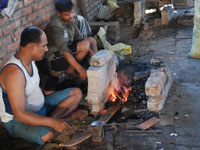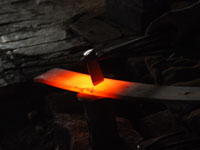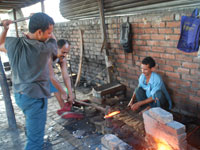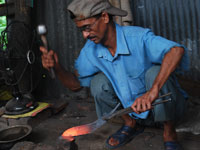Making a Khukuri
How your khukuri was made?
 Nepal is the country of thousands of tribes, among them, a clan is called Bishwakarma/ironsmeeth/blackameethor Kami who makes khukuri/kukri. The Khukur/kukrii making is one of the oldest professions of Kamis. Their source of incoming is only crafting these blades(khukuri/kukri). More than 10,000 blacksmiths have been involving in making Khukuris/kukris in Nepal. Among them we have selected expertise to make each blade. A different tribe called Saarki makes the sheath of a blade. Therefore combination of these both tribes’ craftsmanship, a single khukuri is complete. Our skill craftsmen (Master in blade making) forge finest Khukuri in Nepal, probably the best quality knife in the world.
Nepal is the country of thousands of tribes, among them, a clan is called Bishwakarma/ironsmeeth/blackameethor Kami who makes khukuri/kukri. The Khukur/kukrii making is one of the oldest professions of Kamis. Their source of incoming is only crafting these blades(khukuri/kukri). More than 10,000 blacksmiths have been involving in making Khukuris/kukris in Nepal. Among them we have selected expertise to make each blade. A different tribe called Saarki makes the sheath of a blade. Therefore combination of these both tribes’ craftsmanship, a single khukuri is complete. Our skill craftsmen (Master in blade making) forge finest Khukuri in Nepal, probably the best quality knife in the world.
All the Khukuris are specially hand crafted and designed. The making of a single blades keeps four men fully occupied for an entire day; some time even more. All raw materials such as steel, brass rosewood, buffalo horns and hides and other necessary things are first carefully selected and only the best are utilizes. Craftsmen themselves collect the buffalo hides, horns, woods (for handle) and coals from their own villages. The steel (car, buses or trucks spring), brass, white metal, and other essential metals are available at the local markets, and then only the actual process of making the Khukuris started, Most of the craftsmen make the Khukuri/kukri in their own home. Help of others family members’ play a vital rule to craft best Khukuri.
The Kukri/knife begins as a piece of high-grade steel, a chunk of railway track or car spring being the material of choice although trunk springs serve nearly as well. A length is sliced from the rail, and repeatedly heated and hammered on the anvil, which is usually a sledge-hammer or a maul head embedded in the ground alongside the charcoal-fueled forge. Finally the blade is annealed and fine tempered with water poured from a teapot. The forges are little more than holes in the ground and serve as the smiths’ stove, the rice pot or the singeing chicken being whisked off and on as the incandescent billet of steel passes from furnace to anvil and back.
The hilt is carved of rhododendron wood, carefully ribbed to ensure a good grip when things get sticky. Buffalo horn, at least for civilian models, is also employed. The semi-finished blade is secured to the hilt by inserting its spike-like tang into the handle, rather than being a bar-like shank and riveted. The latter method would seem to be the stronger, but it is claimed that a Khukuri assembled in the traditional manner has never broken in combat. There is precious little chance of one being returned by an unsatisfied customer, for the battle knives are rigorously inspected before being accepted and issued to the men whose lives depend on them. The bronze ferrule and other fittings are not machined but individually crafted and fitted to each weapon.
Everything including sharpening, tempering, on the edge of the blade and shaping the sheath are done by the hand with carefully and only the machine is used to lathe for shining the Khukuri. Finally it is checked in every aspect very carefully before sending at the show room/warehouse in Kathmandu.





